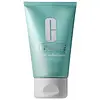What's inside
What's inside
 Key Ingredients
Key Ingredients

 Benefits
Benefits

 Concerns
Concerns

No concerns
 Ingredients Side-by-side
Ingredients Side-by-side

Glycerin
HumectantSodium Laureth Sulfate
CleansingSodium Chloride
MaskingLauramidopropyl Betaine
CleansingButylene Glycol
HumectantSucrose
HumectantSodium Hyaluronate
HumectantGentiana Lutea Root Extract
Skin ConditioningLaminaria Saccharina Extract
Skin ProtectingCaffeine
Skin ConditioningAcetyl Glucosamine
Skin ConditioningLaureth-2
CleansingPEG-120 Methyl Glucose Dioleate
EmulsifyingSodium Sulfate
Benzophenone-4
UV AbsorberSodium Hydroxide
BufferingEDTA
Disodium EDTA
BHT
AntioxidantPhenoxyethanol
PreservativeCI 42090
Cosmetic ColorantGlycerin, Sodium Laureth Sulfate, Sodium Chloride, Lauramidopropyl Betaine, Butylene Glycol, Sucrose, Sodium Hyaluronate, Gentiana Lutea Root Extract, Laminaria Saccharina Extract, Caffeine, Acetyl Glucosamine, Laureth-2, PEG-120 Methyl Glucose Dioleate, Sodium Sulfate, Benzophenone-4, Sodium Hydroxide, EDTA, Disodium EDTA, BHT, Phenoxyethanol, CI 42090
 Reviews
Reviews

Ingredients Explained
These ingredients are found in both products.
Ingredients higher up in an ingredient list are typically present in a larger amount.
BHT is a synthetic antioxidant and preservative.
As an antioxidant, it helps your body fight off free-radicals. Free-radicals are molecules that may damage your skin cells.
As a preservative, it is used to stabilize products and prevent them from degrading. Specifically, BHT prevents degradation from oxidation.
The concerns related to BHT come from oral studies; this ingredient is currently allowed for use by both the FDA and EU.
However, it was recently restricted for use in the UK as of April 2024.
Learn more about BHTDisodium EDTA plays a role in making products more stable by aiding other preservatives.
It is a chelating agent, meaning it neutralizes metal ions that may be found in a product.
Disodium EDTA is a salt of edetic acid and is found to be safe in cosmetic ingredients.
Learn more about Disodium EDTAGlycerin is already naturally found in your skin. It helps moisturize and protect your skin.
A study from 2016 found glycerin to be more effective as a humectant than AHAs and hyaluronic acid.
As a humectant, it helps the skin stay hydrated by pulling moisture to your skin. The low molecular weight of glycerin allows it to pull moisture into the deeper layers of your skin.
Hydrated skin improves your skin barrier; Your skin barrier helps protect against irritants and bacteria.
Glycerin has also been found to have antimicrobial and antiviral properties. Due to these properties, glycerin is often used in wound and burn treatments.
In cosmetics, glycerin is usually derived from plants such as soybean or palm. However, it can also be sourced from animals, such as tallow or animal fat.
This ingredient is organic, colorless, odorless, and non-toxic.
Glycerin is the name for this ingredient in American English. British English uses Glycerol/Glycerine.
Learn more about GlycerinSodium Hyaluronate is hyaluronic acid's salt form. It is commonly derived from the sodium salt of hyaluronic acid.
Like hyaluronic acid, it is great at holding water and acts as a humectant. This makes it a great skin hydrating ingredient.
Sodium Hyaluronate is naturally occurring in our bodies and is mostly found in eye fluid and joints.
These are some other common types of Hyaluronic Acid:
Learn more about Sodium Hyaluronate